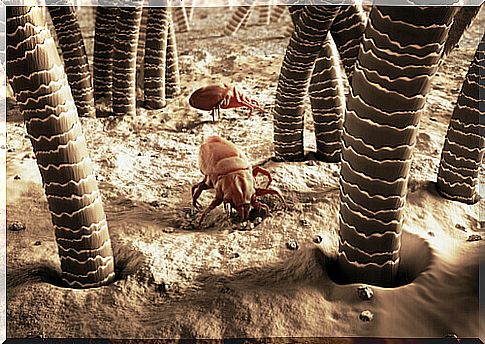Mange In Dogs: Symptoms And Treatment

Mange is one of the most common parasitic dermatoses affecting a wide variety of mammals, including humans. Although cases of mange in pets such as dogs are decreasing, it is important for owners to know the symptoms of a possible infection.
Mange, scientifically called sarcoptic mange, is one of the best known diseases. The reasons are many, among these, the high number of epidemics that have occurred in history and the interspecific diversity of the affected species. It is a parasitic disease caused by the Sarcoptes scabiei var mite. canis .
This parasite is distinguished by the speed with which it spreads throughout the body and by its ease of infecting new victims. The females of these mites settle under the animal’s skin and lay their eggs there.
Although sarcoptic mange is one of the main varieties of mange in dogs, ear mange (or ear mange) is also a very common infection. It is caused by the Otodectes cynotis mite . This parasite infects the ear causing inflammation of the external ear canal.
Symptoms of mange in dogs
Although most dogs with mange infections have a number of common symptoms, not all animals have the same disease process. This is due to the fact that the severity of skin lesions can vary from specimen to specimen.

Usually, the first sign of the disease is sudden, intense itching. In part, this itching is due to the sensitivity of the skin to the droppings of the mites that spread under the skin of the animal.
In the initial phase, this infectious process causes bumps in the dog’s body. When the dog scratches or bites to relieve itching, sores and scabs are created on the skin. In addition, the affected areas may show signs of alopecia.
Also in the initial phase, the signs of mange in dogs are limited to localized areas such as the ears, muzzle or elbows. In a second phase, due to the rapid spread of the mites, the chest, abdomen or even the whole body can also present the characteristic skin lesions of rabies.
The term “mange in disguise” is used in cases where the disease is difficult to diagnose. Usually, it is present in those dogs whose coat, although there are mites, has a clean and well-groomed appearance due to regular hygiene and brushing.
Diagnosis and treatment
If you suspect your dog may have mange, we recommend that you go to the vet right away. This way, in addition to preventing the spread of lesions throughout the animal’s body, you will reduce the risk of infections.

To make the diagnosis, the vet will subject the dog to a physical examination and perform skin scrapings in the affected areas. They may also do blood and stool tests to check for the parasite.
Regarding treatment, it is important that the dog and infected people who have come into contact with the animal undergo drug treatment. The drugs can be administered orally or topically. In addition, it is necessary to carry out a preventive shave in the affected areas.
At the same time, an anti-seborrheic shampoo can be used to soften the scabs.
Both in the healing process and in the prevention of the disease, it is of fundamental importance that the dog maintains good hygiene habits. This not only means frequent bathing and washing, but also preventing the dog from coming into contact with other animals. We must not forget that stray dogs and cats are often the first vectors of infections.
Fortunately, mange in dogs is one of the parasitic diseases of less concern today. The number of cases of mange in pets is greatly reduced and with early diagnosis this disease can be cured quickly. However, it is important to take into account the ease of interspecific transmission, which has caused many mange outbreaks throughout history.








